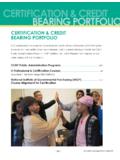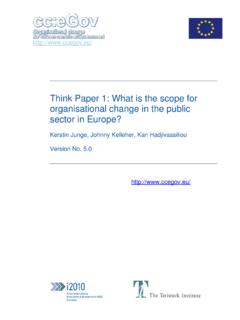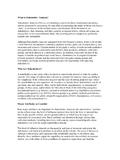Transcription of Red Tape Challenge (United Kingdom) - OECD.org
1 1 Red tape Challenge ( united kingdom ) Source: OECD (2016), Pilot database on stakeholder engagement practices in regulatory policy, Provider of information Answers Organisation Department for Business, Innovation & Skills, united kingdom Division Better Regulation Executive Name (optional) Ben Holley Overview of the practice Answers Name of practice Red tape Challenge If available, please provide links that provide further information about the practice or attach documents. Red tape Challenge website Overview of all Themes Red tape Challenge Scraps and Improves as at December 2014 Is this practice ongoing or was it applied only during a limited amount of time/at one specific occasion?
2 Practice applied for a limited amount of time or at one specific occasion In what year was the practice launched? 2011 Was the practice updated/reformed since then? If yes, when and how has it evolved over time? No Please describe the practice, including information on Features of the practice that you consider its key strengths Key challenges faced during the implementation of the practice Main results of the practice. The Red tape Challenge (RTC) was run by the UK government between 2011 and 2014. It was designed to crowdsource the views from businesses, organisations and the public on which regulations should be improved, kept or scrapped.
3 The initial scope included 21,000 statutory rules and regulations and the enforcement of regulations. Regulations in relation to tax or national security were excluded. The consultations during the RTC finally covered 5,662 regulations in 28 Themes and over 100 Sub-Themes. Crowdsourcing is a means of decentralizing decision-making by asking the crowd to express their views, propose solutions and give insights on a particular issue and then using these views in public policy. The Red tape Challenge programme invited the general public to comment via the internet on the usefulness of regulations within a set time limit. People could comment (anonymously) both publically through comments on the website or through a non-public e-mail inbox.
4 The regulations in scope were clustered in 28 Themes. 6 Themes covered general regulations ( , Equalities, Environment) and were open throughout the entire time. 20 Themes covered a specific sector or industry and were open for consultation over several weeks 2 each ("Theme Spotlight"). 2 additional Themes covered "Disruptive Business Models/Challenger Businesses" and "Enforcement" and were open for consultation during dedicated periods. Over 30,000 comments from the public were received during the Red tape Challenge . These were then used to assess whether regulations should be kept, scrapped or improved. Please provide specific details or examples to illustrate the practice (including supporting links and documents).
5 Overview of the Theme Health and Safety Overview of regulations in the Sub-Theme Higher risk workplaces Comments in the Sub-Theme Higher risk workplaces Excel list with deregulatory measures for the Theme Health and Safety (incl. decision and status of implementation) What stage(s) in the process of policy making does the practice relate to? (Please tick all that apply) Early-stage in the development of regulations (before draft) Later-stage in the development of regulations (during draft) Implementation (incl. transparency/accessibility) X Ex-post evaluation of regulations Review of regulatory policy What were the objectives of the practice?
6 The Red tape Challenge aimed to reduce cost to business by removing regulatory burdens unless they could be justified. Specifically, the objective was to scrap or improve at least 3,000 regulations and save 850m per year for business. Main actors involved in the practice Answers Responsible authority Cabinet Office Country united kingdom Level of government ( national/regional/municipal level) National government Were partners involved in preparing, implementing or evaluating the practice? If yes, please list the partners and describe their involvement. Yes. Departments were given responsibility for the regulatory change process from start to finish for the Themes relating to their respective policy area.
7 Independent advisors representing the interests of businesses or the industry took the role of Sector Champions. They supported the review of suggestions for their respective Theme. Private companies played a significant role in contributing to the crowd sourcing element of the Red tape Challenge . Stakeholder involvement Answers 3 Which methods were used to involve stakeholders for the practice? Stakeholder interaction happened via an interactive website. In addition, Sector Champions represented businesses and industries (see above) and stakeholder groups as well as business panels were assembled to review suggestions. Sector Champions were selected on the basis that they were both highly knowledgeable and well respected within the relevant sector.
8 Each theme had a sector champion and they were invited to take part in Star Chambers and consulted throughout the process. Which stakeholder groups were involved? General public, primarily businesses. How were stakeholders notified of the engagement opportunity? For each Theme, communication activities were conducted. For example, stakeholders were updated about the progress through LinkedIn and Twitter. At the launch of the programme, Op Eds were used in national press and engagement with the public was continuous throughout the programme via social media and email. What inputs were received from stakeholders ( , brief comments, position papers)?
9 The Challenge collected over 30,000 comments and private submissions to an e-mail inbox. Commentators could decide whether to be anonymous or not. A government estimate from January 2011 suggested that about 12% of the comments submitted on the website and 43% of inbox submissions were considered useful by the respective departments. An external company was used for the moderation of website comments. This eliminated comments that were abusive or inappropriate. The remaining comments were assessed by the home department to ascertain whether reform was possible and/or realistic. How were inputs from stakeholders used and by whom? After the consultation phase, the responsible departments had 5-6 weeks to deliver proposals and arguments on whether to scrap, modify, improve or keep regulations.
10 These proposals were challenged internally by so-called Tiger Teams made up of departmental staff who would Challenge their own policies independently of RTC, and externally by Sector Champions, stakeholder groups or business panels. The proposals were then reviewed in the Star Chamber , which was chaired by the Cabinet Office and Business, Innovation and Skills ministers and involved key Coalition advisors. After this, the Star Chamber issued a recommendation to which departments could respond. Finally, the Cabinet sub-committee decided on actual changes, supported by other Cabinet sub-committees where necessary. Was participation limited?

















